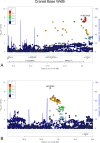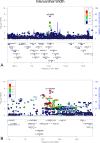Genome-Wide Association Study Reveals Multiple Loci Influencing Normal Human Facial Morphology
- PMID: 27560520
- PMCID: PMC4999139
- DOI: 10.1371/journal.pgen.1006149
Genome-Wide Association Study Reveals Multiple Loci Influencing Normal Human Facial Morphology
Abstract
Numerous lines of evidence point to a genetic basis for facial morphology in humans, yet little is known about how specific genetic variants relate to the phenotypic expression of many common facial features. We conducted genome-wide association meta-analyses of 20 quantitative facial measurements derived from the 3D surface images of 3118 healthy individuals of European ancestry belonging to two US cohorts. Analyses were performed on just under one million genotyped SNPs (Illumina OmniExpress+Exome v1.2 array) imputed to the 1000 Genomes reference panel (Phase 3). We observed genome-wide significant associations (p < 5 x 10-8) for cranial base width at 14q21.1 and 20q12, intercanthal width at 1p13.3 and Xq13.2, nasal width at 20p11.22, nasal ala length at 14q11.2, and upper facial depth at 11q22.1. Several genes in the associated regions are known to play roles in craniofacial development or in syndromes affecting the face: MAFB, PAX9, MIPOL1, ALX3, HDAC8, and PAX1. We also tested genotype-phenotype associations reported in two previous genome-wide studies and found evidence of replication for nasal ala length and SNPs in CACNA2D3 and PRDM16. These results provide further evidence that common variants in regions harboring genes of known craniofacial function contribute to normal variation in human facial features. Improved understanding of the genes associated with facial morphology in healthy individuals can provide insights into the pathways and mechanisms controlling normal and abnormal facial morphogenesis.
Conflict of interest statement
The authors have declared that no competing interests exist.
Figures





Comment in
-
New Entries in the Lottery of Facial GWAS Discovery.PLoS Genet. 2016 Aug 25;12(8):e1006250. doi: 10.1371/journal.pgen.1006250. eCollection 2016 Aug. PLoS Genet. 2016. PMID: 27560833 Free PMC article. No abstract available.
Similar articles
-
EDAR, LYPLAL1, PRDM16, PAX3, DKK1, TNFSF12, CACNA2D3, and SUPT3H gene variants influence facial morphology in a Eurasian population.Hum Genet. 2019 Jun;138(6):681-689. doi: 10.1007/s00439-019-02023-7. Epub 2019 Apr 25. Hum Genet. 2019. Retraction in: Hum Genet. 2021 Oct;140(10):1499. doi: 10.1007/s00439-021-02352-6. PMID: 31025105 Retracted.
-
A genome-wide association study identifies five loci influencing facial morphology in Europeans.PLoS Genet. 2012 Sep;8(9):e1002932. doi: 10.1371/journal.pgen.1002932. Epub 2012 Sep 13. PLoS Genet. 2012. PMID: 23028347 Free PMC article.
-
Novel genetic loci affecting facial shape variation in humans.Elife. 2019 Nov 26;8:e49898. doi: 10.7554/eLife.49898. Elife. 2019. PMID: 31763980 Free PMC article.
-
Genomewide Association Study of African Children Identifies Association of SCHIP1 and PDE8A with Facial Size and Shape.PLoS Genet. 2016 Aug 25;12(8):e1006174. doi: 10.1371/journal.pgen.1006174. eCollection 2016 Aug. PLoS Genet. 2016. PMID: 27560698 Free PMC article.
-
Developmental mechanisms underlying variation in craniofacial disease and evolution.Dev Biol. 2016 Jul 15;415(2):188-197. doi: 10.1016/j.ydbio.2015.12.019. Epub 2015 Dec 24. Dev Biol. 2016. PMID: 26724698 Review.
Cited by
-
The effects of Tbx15 and Pax1 on facial and other physical morphology in mice.FASEB Bioadv. 2021 Sep 3;3(12):1011-1019. doi: 10.1096/fba.2021-00094. eCollection 2021 Dec. FASEB Bioadv. 2021. PMID: 34938962 Free PMC article.
-
Body size and allometric variation in facial shape in children.Am J Phys Anthropol. 2018 Feb;165(2):327-342. doi: 10.1002/ajpa.23356. Epub 2017 Nov 27. Am J Phys Anthropol. 2018. PMID: 29178597 Free PMC article.
-
The genetics of obstructive sleep apnoea.Respirology. 2018 Jan;23(1):18-27. doi: 10.1111/resp.13212. Epub 2017 Nov 7. Respirology. 2018. PMID: 29113020 Free PMC article. Review.
-
Genome-wide mapping of global-to-local genetic effects on human facial shape.Nat Genet. 2018 Mar;50(3):414-423. doi: 10.1038/s41588-018-0057-4. Epub 2018 Feb 19. Nat Genet. 2018. PMID: 29459680 Free PMC article.
-
Epigenetic regulation of craniofacial development and disease.Birth Defects Res. 2024 Jan;116(1):e2271. doi: 10.1002/bdr2.2271. Epub 2023 Nov 14. Birth Defects Res. 2024. PMID: 37964651 Free PMC article. Review.
References
-
- Byard PJ, Poosha DVR, Satyanarayana M, Rao DC. Family resemblance for components of craniofacial size and shape. J Craniofac Genet Dev Biol. 1985;5:229–238. - PubMed
-
- Carels C, Van Cauwenberghe N, Savoye I, Willems G, Loos R, Derom C, et al. A quantitative genetic study of cephalometric variables in twins. Orthod Craniofacial Res. 2001;4:130–140. - PubMed
-
- Ermakov S, Kobyliansky E, Livshits G. Complex segregation analysis of two principal components derived from horizontal and vertical head size traits. Ann Hum Biol. 2006;33:546–556. - PubMed
Publication types
MeSH terms
Substances
Grants and funding
LinkOut - more resources
Full Text Sources
Other Literature Sources

